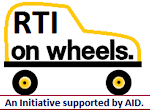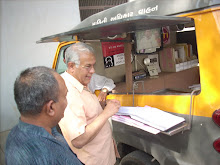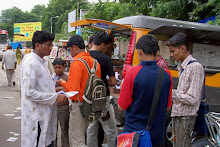The Statesman: New Delhi: Sunday, 15th June
2025.
The Parliament of India, in 2005, enacted what would become one of the strongest Right to Information (RTI) laws in the world. 15 June 2025, marks the 20th anniversary of the passage of the RTI Act, which fully came into force on 12 October 2005.
The Parliament of India, in 2005, enacted what would become one of the strongest Right to Information (RTI) laws in the world. 15 June 2025, marks the 20th anniversary of the passage of the RTI Act, which fully came into force on 12 October 2005. The law’s passage reflects a rare bipartisan legacy, building on the foundation of the Freedom of Information Act, 2002, passed under the preceding NDA government led by Prime Minister Atal Bihari Vajpayee, which was then repealed and strengthened into the RTI Act, 2005, by the UPA government under Prime Minister Dr. Manmohan Singh.
Twenty years later, it has empowered millions. From schoolchildren securing evaluated answer sheets (CBSE v. Aditya Bandopadhyay, 2011), to journalists exposing scams, the Act has transformed passive recipients into armchair auditors. Over 132 countries have RTI laws, starting with Sweden’s 1766 Freedom of the Press Act. In 2024, the world saw 63,99,921 Access to Information requests, with India’s Central public authorities handling 17,50,863 lakh RTI applications and many more in states ~ Maharashtra alone receiving over 7 lakh annually. India’s RTI Act ranks 8th globally among 136 countries, according to the ‘RTI Rating’ by the Centre for Law and Democracy.
The Indian success with RTI has inspired transparency laws in Nepal, Bangladesh, and Sri Lanka. Nepal’s 2007 Act covers political parties, while Bangladesh’s 2009 law ensures Information Commission auto – nomy ~ areas for India to emulate. UNESCO, as the custodian agency, reports on worldwide progress towards Sustainable Development Goal (SDG) indicator 16.10.2, which measures the “number of countries that adopt and implement constitutional, statutory and/or policy guarantees for public access to information” The 1984 Bhopal gas disaster, which claimed over 15,000 lives, starkly illustrates why secrecy can be deadly. As Harvard Professor Sheila Jasanoff wrote, Bhopal was not just an industrial accident; it was a failure of knowledge ~ a lack of timely access to critical information for the people living in neighbourhoods, which could have saved lives.
The tragedy underscores the need for a dedicated Environmental Right to Information law in India. Covid-19 has brought into light the value of transparency of information in containing the pandemic and how secrecy in early days contributed to its spread across nations. Even on the origin of Covid19, Freedom of information could throw some light. American Professor Nicholas Wade published critical data, obtained through a FOIA request to the National Institutes of Health and a 12-month delay that described risky experiments on hybrid coronaviruses, carried out in Wuhan with the support of EcoHealth and the U.S. government.
This compelled the White House to release a declassified report acknowledging that the lab-origin theory remains scientifically plausible. In India, citizens filed applications seeking information on gaps in public health preparedness, death data, and the PM CARES Fund. The pandemic gave us a message: right to information is a lifesaving right. Bihar introduced a helpline to simplify the RTI filing process, while the Central Government launched an online portal to streamline applications. The Supreme Court directed all High Courts and state governments to set up online RTI portals. The Central Information Commission began holding video hearings through district NIC centres. Maharashtra pioneered the establishment of eight regional benches to improve access.
The law requires proactive disclosure of as much information as possible “so that the public have minimum resort to the use of this Act to obtain information.” In Kishan Chand Jain v. Delhi (2023), the Supreme Court directed Information Commissions to actively monitor compliance with this mandate. Platforms like data.gov.in and third-party audits have further strengthened the culture of transparency. The RTI Act’s ambit over the private sector remains limited, even for entities performing public functions or PublicPrivate Partnerships. Other co – untries offer models for reform: South Africa’s Promotion of Access to Information Act allows access to records from private bodies when necessary to protect people’s rights, and the UK’s Freedom of Information Act has provisions to extend its ambit to private organizations performing public functions.
The Digital Personal Data Protection Act, 2023 (DPDP), marks a pivotal moment in India’s journey toward safeguarding the fundamental right to privacy, as affirmed by the Supreme Court in the landmark Justice K.S. Puttaswamy judgment of 2017. However, the DPDP Act threatens to curtail RTI’s scope. Its amendment to Section 8(1)(j) replaces the existing “public interest override” with a blanket exemption for personal information. This could prevent citizens from accessing crucial public interest data involving public servants. The removal of the proviso ~ that information not denied to Parliament cannot be denied to the public ~ further weakens the Act. However, Section 8(2) remains un – touched ~ it allows disclosure when public interest out weighs harm. Both rights are fundamental – privacy under Article 21 and the right to information under Article 19(1) (a). Conflicts often arise when disclosure of public records may reveal personal data, in matters involving public officials.
The Electoral Bonds case (Association for Democratic Reforms v. Union of India, 2024) provides a landmark precedent for this balancing exercise. The Supreme Court struck down the Electoral Bond Scheme, holding that voters’ right to know the sources of political funding outweighed the donors’ right to privacy. The Court reasoned that political donations are not purely private acts ~ they are intended to influence public policy and elections and thus lie within the public domain. Applying this “double proportionality test,” the Court assessed the extent of infringement on both rights and concluded that transparency was essential to preserving electoral integrity, preventing quid pro quo arrangements, and upholding constitutional morality.
A key reform could be to merge the responsibilities of data protection and information access under a single, independent body, similar to the UK’s Information Commission, to ensure a balanced and coherent approach to both rights. India’s Information Commissions, especially in states, are plagued by high pendency, political appointments, and lack of financial independence. Appointments are often drawn from retired bureaucrats with no cooling-off period ~ raising questions of conflict of interest. Countries like Hungary mandate a four-year gap before such appointments; India must consider similar safeguards. Transparent selection, as seen in the UK’s public hearings, would enhance public trust. Moreover, despite Parliament passing the Whistle Blowers Protection Act in 2014, it remains unimplemented. Several RTI users have faced threats, and even death.
A robust whistle-blower system, allowing anonymous filing as in Mexico’s ‘Infomex’ portal, is urgently needed. A public expenditure tracking portal ~ similar to the U.S. usaspending.gov ~ would enh – an ce fiscal transparency and citizen trust. To address black money, India could even consider making tax records public, a practice already in place in Norway, Finland, and Sweden. Despite the RTI’s success, India has withdrawn from the Open Government Partnership (OGP), a global initiative to promote transparency, ceding its leadership role in this space. RTI remains largely an urban phenomenon. There is a pressing need to take RTI to the villages, especially through the Gram Sabha, a key platform for transparency and accountability. It empowers villagers ~ especially women ~ to access information on local development schemes, public funds, and decision-making, thereby fostering informed rural citizenship. Women in India are not able to exercise the right to information with the same facility (frequency, ease and rate of success) as men.
Women are filing less than 18 per cent of online RTI applications (2013– 2023, DoPT). Governments and Civil Society should take serious note of this concern and start working towards ensuring gender equality in RTI activism. A free flow of information can transform lives. Women should be encouraged to use the power of information for economic empowerment and fulfilment and protection of rights. Over the past two decades, the silent efforts of Public Information Officers have kept the RTI system alive, often without recognition or adequate resources. RTI is now widely regarded as an essential element of modern democracy. As Justice Sanjiv Khanna observed, “Democracy is hollow without meaningful participation.”
(The writer is a Transparency and equality advocate and author Opinions are personal)
The Parliament of India, in 2005, enacted what would become one of the strongest Right to Information (RTI) laws in the world. 15 June 2025, marks the 20th anniversary of the passage of the RTI Act, which fully came into force on 12 October 2005.
The Parliament of India, in 2005, enacted what would become one of the strongest Right to Information (RTI) laws in the world. 15 June 2025, marks the 20th anniversary of the passage of the RTI Act, which fully came into force on 12 October 2005. The law’s passage reflects a rare bipartisan legacy, building on the foundation of the Freedom of Information Act, 2002, passed under the preceding NDA government led by Prime Minister Atal Bihari Vajpayee, which was then repealed and strengthened into the RTI Act, 2005, by the UPA government under Prime Minister Dr. Manmohan Singh.
Twenty years later, it has empowered millions. From schoolchildren securing evaluated answer sheets (CBSE v. Aditya Bandopadhyay, 2011), to journalists exposing scams, the Act has transformed passive recipients into armchair auditors. Over 132 countries have RTI laws, starting with Sweden’s 1766 Freedom of the Press Act. In 2024, the world saw 63,99,921 Access to Information requests, with India’s Central public authorities handling 17,50,863 lakh RTI applications and many more in states ~ Maharashtra alone receiving over 7 lakh annually. India’s RTI Act ranks 8th globally among 136 countries, according to the ‘RTI Rating’ by the Centre for Law and Democracy.
The Indian success with RTI has inspired transparency laws in Nepal, Bangladesh, and Sri Lanka. Nepal’s 2007 Act covers political parties, while Bangladesh’s 2009 law ensures Information Commission auto – nomy ~ areas for India to emulate. UNESCO, as the custodian agency, reports on worldwide progress towards Sustainable Development Goal (SDG) indicator 16.10.2, which measures the “number of countries that adopt and implement constitutional, statutory and/or policy guarantees for public access to information” The 1984 Bhopal gas disaster, which claimed over 15,000 lives, starkly illustrates why secrecy can be deadly. As Harvard Professor Sheila Jasanoff wrote, Bhopal was not just an industrial accident; it was a failure of knowledge ~ a lack of timely access to critical information for the people living in neighbourhoods, which could have saved lives.
The tragedy underscores the need for a dedicated Environmental Right to Information law in India. Covid-19 has brought into light the value of transparency of information in containing the pandemic and how secrecy in early days contributed to its spread across nations. Even on the origin of Covid19, Freedom of information could throw some light. American Professor Nicholas Wade published critical data, obtained through a FOIA request to the National Institutes of Health and a 12-month delay that described risky experiments on hybrid coronaviruses, carried out in Wuhan with the support of EcoHealth and the U.S. government.
This compelled the White House to release a declassified report acknowledging that the lab-origin theory remains scientifically plausible. In India, citizens filed applications seeking information on gaps in public health preparedness, death data, and the PM CARES Fund. The pandemic gave us a message: right to information is a lifesaving right. Bihar introduced a helpline to simplify the RTI filing process, while the Central Government launched an online portal to streamline applications. The Supreme Court directed all High Courts and state governments to set up online RTI portals. The Central Information Commission began holding video hearings through district NIC centres. Maharashtra pioneered the establishment of eight regional benches to improve access.
The law requires proactive disclosure of as much information as possible “so that the public have minimum resort to the use of this Act to obtain information.” In Kishan Chand Jain v. Delhi (2023), the Supreme Court directed Information Commissions to actively monitor compliance with this mandate. Platforms like data.gov.in and third-party audits have further strengthened the culture of transparency. The RTI Act’s ambit over the private sector remains limited, even for entities performing public functions or PublicPrivate Partnerships. Other co – untries offer models for reform: South Africa’s Promotion of Access to Information Act allows access to records from private bodies when necessary to protect people’s rights, and the UK’s Freedom of Information Act has provisions to extend its ambit to private organizations performing public functions.
The Digital Personal Data Protection Act, 2023 (DPDP), marks a pivotal moment in India’s journey toward safeguarding the fundamental right to privacy, as affirmed by the Supreme Court in the landmark Justice K.S. Puttaswamy judgment of 2017. However, the DPDP Act threatens to curtail RTI’s scope. Its amendment to Section 8(1)(j) replaces the existing “public interest override” with a blanket exemption for personal information. This could prevent citizens from accessing crucial public interest data involving public servants. The removal of the proviso ~ that information not denied to Parliament cannot be denied to the public ~ further weakens the Act. However, Section 8(2) remains un – touched ~ it allows disclosure when public interest out weighs harm. Both rights are fundamental – privacy under Article 21 and the right to information under Article 19(1) (a). Conflicts often arise when disclosure of public records may reveal personal data, in matters involving public officials.
The Electoral Bonds case (Association for Democratic Reforms v. Union of India, 2024) provides a landmark precedent for this balancing exercise. The Supreme Court struck down the Electoral Bond Scheme, holding that voters’ right to know the sources of political funding outweighed the donors’ right to privacy. The Court reasoned that political donations are not purely private acts ~ they are intended to influence public policy and elections and thus lie within the public domain. Applying this “double proportionality test,” the Court assessed the extent of infringement on both rights and concluded that transparency was essential to preserving electoral integrity, preventing quid pro quo arrangements, and upholding constitutional morality.
A key reform could be to merge the responsibilities of data protection and information access under a single, independent body, similar to the UK’s Information Commission, to ensure a balanced and coherent approach to both rights. India’s Information Commissions, especially in states, are plagued by high pendency, political appointments, and lack of financial independence. Appointments are often drawn from retired bureaucrats with no cooling-off period ~ raising questions of conflict of interest. Countries like Hungary mandate a four-year gap before such appointments; India must consider similar safeguards. Transparent selection, as seen in the UK’s public hearings, would enhance public trust. Moreover, despite Parliament passing the Whistle Blowers Protection Act in 2014, it remains unimplemented. Several RTI users have faced threats, and even death.
A robust whistle-blower system, allowing anonymous filing as in Mexico’s ‘Infomex’ portal, is urgently needed. A public expenditure tracking portal ~ similar to the U.S. usaspending.gov ~ would enh – an ce fiscal transparency and citizen trust. To address black money, India could even consider making tax records public, a practice already in place in Norway, Finland, and Sweden. Despite the RTI’s success, India has withdrawn from the Open Government Partnership (OGP), a global initiative to promote transparency, ceding its leadership role in this space. RTI remains largely an urban phenomenon. There is a pressing need to take RTI to the villages, especially through the Gram Sabha, a key platform for transparency and accountability. It empowers villagers ~ especially women ~ to access information on local development schemes, public funds, and decision-making, thereby fostering informed rural citizenship. Women in India are not able to exercise the right to information with the same facility (frequency, ease and rate of success) as men.
Women are filing less than 18 per cent of online RTI applications (2013– 2023, DoPT). Governments and Civil Society should take serious note of this concern and start working towards ensuring gender equality in RTI activism. A free flow of information can transform lives. Women should be encouraged to use the power of information for economic empowerment and fulfilment and protection of rights. Over the past two decades, the silent efforts of Public Information Officers have kept the RTI system alive, often without recognition or adequate resources. RTI is now widely regarded as an essential element of modern democracy. As Justice Sanjiv Khanna observed, “Democracy is hollow without meaningful participation.”
(The writer is a Transparency and equality advocate and author Opinions are personal)















































































